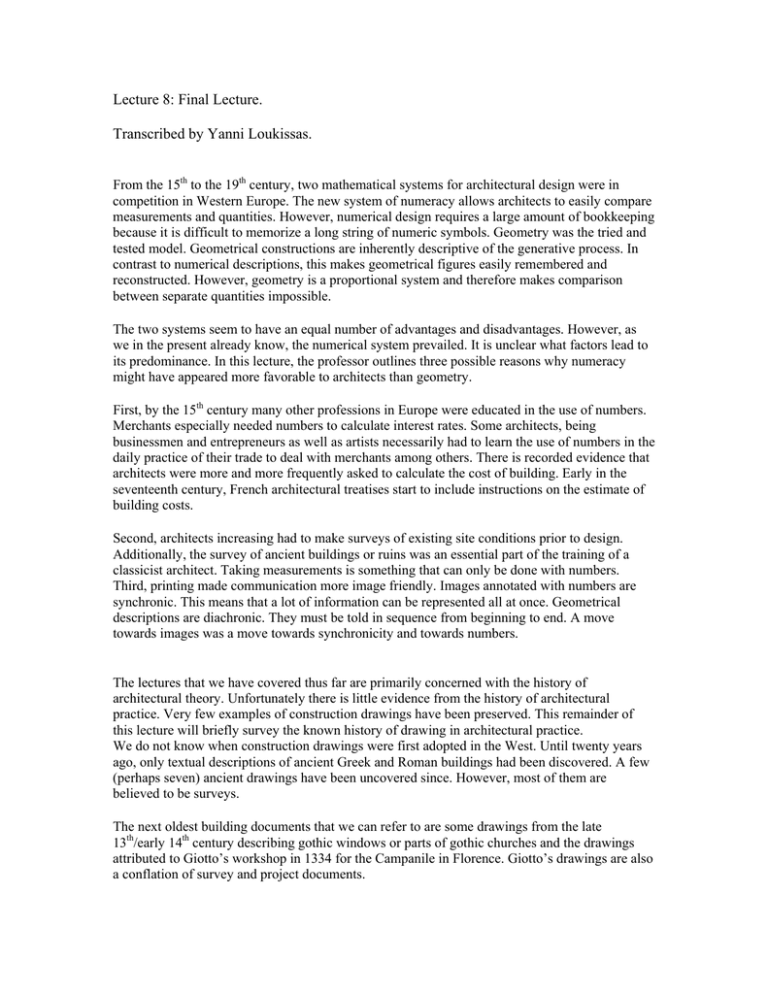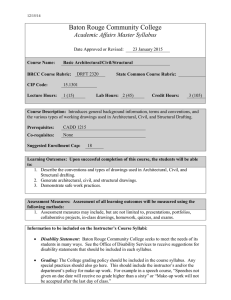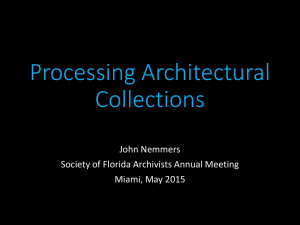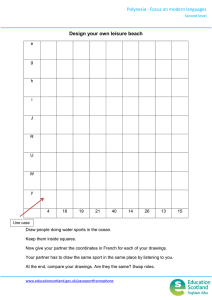Lecture 8: Final Lecture. Transcribed by Yanni Loukissas.
advertisement

Lecture 8: Final Lecture. Transcribed by Yanni Loukissas. From the 15th to the 19th century, two mathematical systems for architectural design were in competition in Western Europe. The new system of numeracy allows architects to easily compare measurements and quantities. However, numerical design requires a large amount of bookkeeping because it is difficult to memorize a long string of numeric symbols. Geometry was the tried and tested model. Geometrical constructions are inherently descriptive of the generative process. In contrast to numerical descriptions, this makes geometrical figures easily remembered and reconstructed. However, geometry is a proportional system and therefore makes comparison between separate quantities impossible. The two systems seem to have an equal number of advantages and disadvantages. However, as we in the present already know, the numerical system prevailed. It is unclear what factors lead to its predominance. In this lecture, the professor outlines three possible reasons why numeracy might have appeared more favorable to architects than geometry. First, by the 15th century many other professions in Europe were educated in the use of numbers. Merchants especially needed numbers to calculate interest rates. Some architects, being businessmen and entrepreneurs as well as artists necessarily had to learn the use of numbers in the daily practice of their trade to deal with merchants among others. There is recorded evidence that architects were more and more frequently asked to calculate the cost of building. Early in the seventeenth century, French architectural treatises start to include instructions on the estimate of building costs. Second, architects increasing had to make surveys of existing site conditions prior to design. Additionally, the survey of ancient buildings or ruins was an essential part of the training of a classicist architect. Taking measurements is something that can only be done with numbers. Third, printing made communication more image friendly. Images annotated with numbers are synchronic. This means that a lot of information can be represented all at once. Geometrical descriptions are diachronic. They must be told in sequence from beginning to end. A move towards images was a move towards synchronicity and towards numbers. The lectures that we have covered thus far are primarily concerned with the history of architectural theory. Unfortunately there is little evidence from the history of architectural practice. Very few examples of construction drawings have been preserved. This remainder of this lecture will briefly survey the known history of drawing in architectural practice. We do not know when construction drawings were first adopted in the West. Until twenty years ago, only textual descriptions of ancient Greek and Roman buildings had been discovered. A few (perhaps seven) ancient drawings have been uncovered since. However, most of them are believed to be surveys. The next oldest building documents that we can refer to are some drawings from the late 13th/early 14th century describing gothic windows or parts of gothic churches and the drawings attributed to Giotto’s workshop in 1334 for the Campanile in Florence. Giotto’s drawings are also a conflation of survey and project documents. Despite the lack of concrete evidence coming from actual practices at building sites, Leon Battista Alberti’s writings from the mid 15th century theorize that design should be expressed with drawings and three-dimensional models and left unchanged during the process of construction. There is evidence that this is indeed the design method that Alberti himself adopted, or at least favored, in some cases. In 1620 Martino Ferrabosco made a survey of St. Peter’s that is both proportionally correct and numerically dimensioned in a way that could be easily understood by today’s engineers. This is the first concrete evidence of full adoption of modern numeracy in construction documents including the precocious and somewhat puzzling adoption of a proportional scale of 1:100. Presently, digital encoding has followed the advance of numerical design and geometrical descriptions have all but disappeared. According to the professor, there are two predominant directions in which digital design may proceed from here. One mode of digital design may involve nothing but a series of computational transformations based on available, industrystandard software. As most software that is currently dominant is programmed using nineteenth century linear algebra and differential calculus, this could be perceived as the ultimate dominance of modern numeracy in design. As of yet, this mode of working remains a theoretical possibility. The other mode of digital age design is a retreat to gestural methods of design where the computer is positioned as a measuring and replicatory device for complex hand-made schemes. This second mode is best exemplified by the pantograph (invented by a German Jesuit in 1631) or by the work of Frank Gehry. It remains to be seen how the computer will figure into the future of architectural practice. At the end of the class, there was some disagreement, amongst those present, as to whether digital means of encoding have ended the competition between numeracy and geometry.




